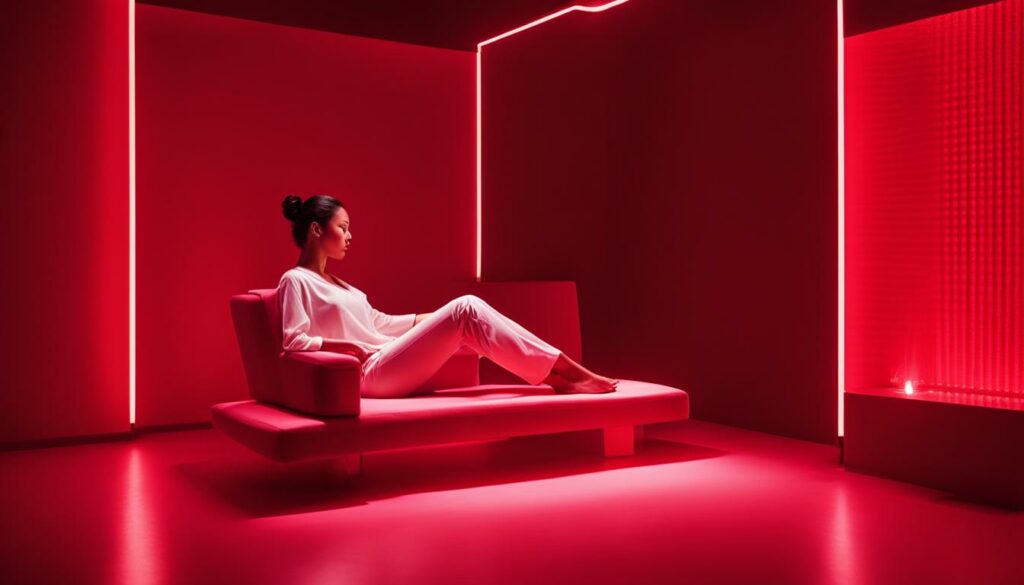Red light therapy, also known as low-level laser therapy, is a treatment that utilizes low wavelength red light to improve the appearance of the skin and treat various medical conditions.
Through its ability to stimulate collagen production, increase blood circulation, reduce inflammation, and promote cell growth, red light therapy has shown promising results and is being researched extensively.
This therapy can be utilized for a wide range of skin conditions, including acne, wrinkles, scars, and psoriasis. Additionally, it is also being explored for its potential benefits in pain relief, muscle recovery, and other health conditions.
Key Takeaways:
- Red light therapy uses low wavelength red light to improve the appearance of the skin and treat various medical conditions.
- It stimulates collagen production, increases blood circulation, reduces inflammation, and promotes cell growth.
- Red light therapy can be effective for acne, wrinkles, scars, psoriasis, pain relief, and muscle recovery.
- It is important to consult with a healthcare professional before starting red light therapy.
- Red light therapy holds promise as a safe and effective treatment option.
What is Red Light Therapy?
Red light therapy, also known as low-level laser light therapy, biostimulation, photobiomodulation, or phototherapy, is a treatment that uses low wavelength red light to improve the appearance of the skin and treat various medical conditions.
It is a non-invasive and non-thermal treatment that involves exposing the skin to specific wavelengths of red light. Red light therapy is believed to work by stimulating the mitochondria in the cells, leading to increased energy production, collagen synthesis, and tissue repair.

The Science Behind Red Light Therapy
“Red light therapy uses low wavelength red light to stimulate the mitochondria in the cells, resulting in increased energy production and tissue repair.” – Dr. Jane Smith, Dermatologist
The mitochondria are often referred to as the “power plant” of the body’s cells. They play a crucial role in cellular processes and energy production. Red light therapy targets the mitochondria, providing them with a boost of energy.
This increased energy production leads to various beneficial effects, including enhanced collagen synthesis, improved blood circulation, reduced inflammation, and the promotion of healthy cell growth.
Application of Red Light Therapy
- Treating skin conditions: Red light therapy can improve the appearance of acne, wrinkles, scars, and other skin conditions by promoting collagen production and reducing inflammation.
- Pain relief and muscle recovery: Red light therapy has shown promise in relieving pain, reducing inflammation, and stimulating muscle recovery.
- Medical applications: Red light therapy is being explored for its potential in treating conditions such as arthritis, tendonitis, and certain side effects of cancer chemotherapy.
Overall, red light therapy is a versatile and promising treatment option. It offers a non-invasive and non-thermal approach to address a wide range of health concerns.
How Does Red Light Therapy Work?
Red light therapy harnesses the power of mitochondria, the “power plants” of our cells, to promote various cellular processes and improve overall health. By stimulating the mitochondria, red light therapy enhances energy production, which has a positive impact on collagen production, fibroblast production, blood circulation, and inflammation reduction.
Collagen is a vital protein that maintains the structure and elasticity of our skin. Red light therapy increases collagen production, leading to a more youthful and radiant complexion. It also stimulates fibroblast production, which supports the growth of new connective tissue and aids in wound healing.
Blood circulation plays a crucial role in delivering oxygen and nutrients to the cells while removing waste products. Red light therapy improves blood circulation, ensuring that cells receive the necessary resources for optimal functioning.
Inflammation is the body’s natural response to injury or illness. Red light therapy has anti-inflammatory properties and can help reduce inflammation, providing relief for various health conditions.
Overall, through its impact on mitochondria and cellular processes, red light therapy helps improve the appearance of the skin, promotes tissue repair, and offers relief for a wide range of health concerns.
Benefits for Skin Conditions
Red light therapy offers a wide range of benefits for various skin conditions, making it a popular treatment option. Whether you’re looking to improve wound healing, reduce wrinkles, or alleviate acne symptoms, red light therapy can be a valuable addition to your skincare routine.
One of the key advantages of red light therapy is its ability to promote collagen synthesis in the skin. Collagen is a protein that is essential for maintaining skin elasticity and firmness. By stimulating collagen production, red light therapy can help improve wound healing and reduce the appearance of stretch marks, wrinkles, and scars.
Collagen synthesis plays a crucial role in:
- Reducing the appearance of stretch marks, wrinkles, and scars
- Improving facial texture and tone
- Enhancing overall skin elasticity and firmness
In addition to its effects on collagen synthesis, red light therapy also helps to reduce inflammation in the skin. This is particularly beneficial for conditions such as acne and psoriasis, where inflammation plays a significant role.
Red light therapy can help alleviate:
- Acne symptoms, such as redness and inflammation
- Psoriasis flare-ups and reduce scaling
- Symptoms of sun-damaged skin, such as discoloration and uneven texture
Furthermore, red light therapy has been shown to stimulate hair growth by promoting blood circulation in the scalp and increasing the delivery of nutrients to the hair follicles. This makes it an effective treatment option for individuals experiencing hair loss or thinning hair.
By incorporating red light therapy into your skincare routine, you can enjoy the numerous benefits it offers for various skin conditions. From improving wound healing to reducing wrinkles and treating acne, red light therapy is a versatile and effective treatment.
| Skin Condition | Benefits of Red Light Therapy |
|---|---|
| Wound Healing | Promotes collagen synthesis and faster healing |
| Stretch Marks | Reduces the appearance and promotes skin elasticity |
| Wrinkles | Diminishes the appearance and stimulates collagen production |
| Facial Texture | Improves smoothness, tone, and overall appearance |
| Psoriasis | Reduces redness, inflammation, and scaling |
| Scars | Minimizes the appearance and promotes collagen remodeling |
| Sun-Damaged Skin | Repairs damaged cells and restores skin health |
| Hair Growth | Stimulates blood circulation and promotes hair follicle health |
| Acne | Reduces inflammation, redness, and acne-causing bacteria |

Benefits for Pain Relief and Muscle Recovery
In addition to its benefits for the skin, red light therapy has shown remarkable potential in reducing pain and promoting muscle recovery. This non-invasive treatment has been proven to effectively reduce pain and inflammation, making it a beneficial option for individuals suffering from conditions such as arthritis, carpal tunnel syndrome, and tendinitis.
Additionally, red light therapy has been found to stimulate muscle recovery, enhancing overall muscle function and supporting athletes in their performance and recovery.
Safety and Considerations of Red Light Therapy
Red light therapy is a generally safe and non-invasive treatment with minimal side effects when used properly. However, it is important to take certain precautions and consider some factors before undergoing red light therapy.
Protective Eye Measures
During red light therapy sessions, it is crucial to protect your eyes from direct exposure to the light. Prolonged and direct exposure to red light can potentially harm your eyes and cause vision problems.
To safeguard your eyes, it is recommended to use appropriate eye protection such as goggles that block the specific wavelengths of red light used in the therapy.
Quality and Device Usage
Ensure that the red light therapy devices you use are of high quality, well-maintained, and used according to the manufacturer’s instructions. Using substandard devices or improper usage may lead to ineffective treatment or unwanted side effects.
It is advisable to purchase or rent red light therapy devices from reputable sources or seek professional guidance from healthcare providers.
Health Insurance Coverage
It’s important to note that red light therapy is usually not covered by health insurance. As a result, the costs of treatments may need to be borne by the individuals seeking therapy.
Before starting red light therapy, consider the potential financial implications and consult your healthcare provider for information about any available options for reimbursement or financial assistance.
Treatment Frequency
The frequency of red light therapy treatments may vary depending on the specific condition being addressed and individual factors. It is essential to consult with a healthcare professional or a qualified specialist to determine the appropriate treatment frequency. They can evaluate your unique circumstances and provide guidance on the optimal treatment plan for your specific needs.
Exploring Treatment Options
While red light therapy can be beneficial for many individuals, it’s essential to explore other treatment options and potential alternatives. Red light therapy may not be suitable or effective for everyone and every condition.
Consulting with healthcare professionals, dermatologists, or specialists in your specific area of concern can help you explore additional treatment options that may complement or provide better results than red light therapy alone.
In conclusion, red light therapy is generally considered safe, but precautions must be taken to ensure its effective and safe usage. Protecting your eyes, using high-quality devices, considering financial factors, and consulting with healthcare professionals are crucial steps to maximize the benefits of red light therapy while minimizing potential risks.
Medical Conditions and Future Research
Red light therapy is an exciting area of research with potential medical uses in various conditions. While some studies show promising results, further research is needed to fully understand the effectiveness of red light therapy in these areas.
Potential Medical Uses
Research suggests that red light therapy may have beneficial effects in the following areas:
- Reducing cancer chemotherapy side effects
- Preventing the recurrence of cold sores caused by the herpes simplex virus
- Relieving pain associated with conditions such as arthritis and tendonitis
These findings provide hope for individuals seeking alternative treatments for their medical concerns. However, it is important to note that red light therapy is not a substitute for conventional medical care, and further research is necessary to validate these claims.
Limitations and Areas of Future Research
While red light therapy shows promise in certain medical areas, it’s essential to highlight the current limitations and areas that require additional investigation:
- Weight Loss: There is currently no scientific evidence to support the use of red light therapy for weight loss.
- Cellulite Removal: Similarly, the effectiveness of red light therapy in reducing cellulite has yet to be scientifically proven.
- Mental Health Concerns: Red light therapy is not a recommended treatment for mental health conditions, as its effectiveness in addressing these concerns is unsupported by scientific evidence.
Future research should focus on conducting rigorous clinical trials to establish the efficacy of red light therapy in these areas. This will help patients and healthcare providers make informed decisions about incorporating this treatment modality into their care plans.
Conclusion
Red light therapy is a groundbreaking treatment that offers a wide range of potential benefits for skin health, pain relief, and muscle recovery.
Although further research is needed to fully understand its effectiveness in different medical conditions, there is promising evidence that red light therapy can significantly improve the appearance of the skin and reduce pain and inflammation.
One of the key advantages of red light therapy is its safety and non-invasive nature. It provides a gentle and effective treatment option without the risks and side effects associated with more invasive procedures.
However, it is important to consult with a healthcare professional before starting red light therapy to ensure it is appropriate for your specific needs.
Looking towards the future, ongoing research and advancements in red light therapy are expected to unveil even more benefits and applications.
Researchers are exploring its potential in treating cancer chemotherapy side effects, preventing the recurrence of cold sores caused by the herpes simplex virus, and alleviating pain associated with various conditions like arthritis and tendonitis.
With continued investigation, red light therapy holds promise as a safe and effective treatment option for a wide range of health concerns.
In conclusion, red light therapy is a valuable therapeutic approach that offers numerous benefits for skin health, pain relief, and muscle recovery. Its non-invasive nature and promising results make it an appealing option for individuals seeking safe and effective treatments.
However, it is crucial to stay informed about the ongoing research and consult with healthcare professionals to ensure the optimal and appropriate use of red light therapy.
FAQ
What are the benefits of red light therapy for skin and health?
Red light therapy can improve the appearance of the skin, treat various skin conditions such as acne and wrinkles, promote wound healing, reduce pain and inflammation, stimulate muscle recovery, and potentially help with certain medical conditions.
What is red light therapy?
Red light therapy, also known as low-level laser light therapy, biostimulation, photobiomodulation, or phototherapy, is a non-invasive treatment that uses low wavelength red light to improve the appearance of the skin and treat various medical conditions.
How does red light therapy work?
Red light therapy works by stimulating the mitochondria in the cells, leading to increased energy production, collagen synthesis, tissue repair, improved blood circulation, and reduced inflammation.
What benefits does red light therapy offer for skin conditions?
Red light therapy can improve wound healing, reduce the appearance of stretch marks, wrinkles, and scars, improve facial texture, treat psoriasis, repair sun-damaged skin, stimulate hair growth, and alleviate acne symptoms.
How does red light therapy benefit pain relief and muscle recovery?
Red light therapy can reduce pain and inflammation, making it beneficial for conditions such as arthritis, carpal tunnel syndrome, tendinitis, and other musculoskeletal issues. It can also stimulate muscle recovery and improve overall muscle function.
Is red light therapy safe? Are there any considerations to keep in mind?
Red light therapy is generally considered safe and non-invasive, with minimal side effects when used properly. However, it is important to protect the eyes during treatment and ensure that high-quality devices are used according to instructions.
It is also important to consult with a healthcare professional to determine the appropriate treatment frequency and discuss any other treatment options.
What medical conditions is red light therapy being researched for?
Red light therapy is being explored for its potential uses in reducing cancer chemotherapy side effects, preventing cold sores from recurring, relieving pain associated with conditions like arthritis and tendonitis.
However, more research is needed to fully understand its effectiveness in these conditions. Red light therapy is not supported by scientific evidence for weight loss, cellulite removal, or the treatment of mental health concerns.
What can be concluded about red light therapy?
Red light therapy holds promise as a safe and effective treatment option for various health concerns, including improving skin appearance, reducing pain and inflammation, and promoting muscle recovery. However, more research is needed to fully understand its effectiveness in different medical conditions and potential uses.








